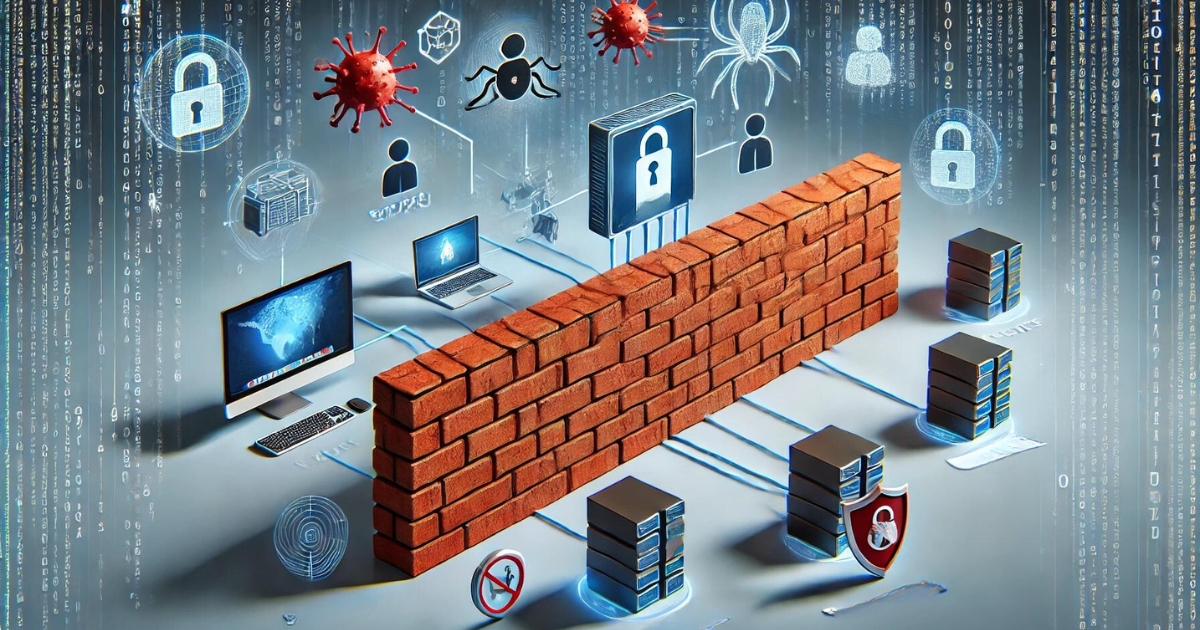Setting up and managing firewalls on a dedicated server is crucial for maintaining robust security. This guide will walk you through the basics of firewalls, choosing the right one for your server, configuring it step-by-step, managing advanced features, avoiding common mistakes, maintaining your firewall, and enhancing security with additional tools.
Key Takeaways
- Understand the basic concepts and importance of firewalls in server security.
- Learn the differences between software and hardware firewalls and how to choose the right one.
- Follow a step-by-step guide to configure firewall zones, rules, and settings.
- Identify and avoid common mistakes in firewall configuration to ensure optimal security.
- Explore advanced management techniques and additional tools to enhance your firewall’s effectiveness.
Understanding Firewall Basics

What is a Firewall?
A firewall acts as a barrier between your server and potential threats from the internet. It monitors incoming and outgoing traffic, allowing or blocking data based on security rules. Firewalls are essential for protecting sensitive information and maintaining the integrity of your server.
Types of Firewalls
There are several types of firewalls, each with its own strengths. Network firewalls philtre traffic between different networks, while host-based firewalls protect individual servers. Some firewalls are software-based, running on your server, and others are hardware devices placed between your server and the internet.
Importance of Firewalls in Server Security
Firewalls play a crucial role in server security by preventing unauthorised access and attacks. They help to ensure that only legitimate traffic reaches your server, reducing the risk of data breaches and other security incidents. Properly configured firewalls are a key component of any robust security strategy.
Choosing the Right Firewall for Your Server

Software vs Hardware Firewalls
When deciding between software and hardware firewalls, it’s essential to consider your specific needs. Hardware firewalls are ideal for on-premises networks, providing robust protection for multiple devices. In contrast, software firewalls are better suited for securing individual devices, especially in a remote or cloud-based environment. Choose a firewall that aligns with your infrastructure and offers reliable performance.
Popular Firewall Solutions
There are numerous firewall solutions available, each with its own set of features and benefits. Some popular options include pfSense, a versatile open-source firewall, and Cisco ASA, known for its enterprise-level security. Evaluating these solutions based on your requirements will help you find the best fit for your server.
Evaluating Firewall Features
When selecting a firewall, it’s crucial to assess the features it offers. Look for essential functionalities such as Intrusion Prevention Systems (IPS), Network Time Protocol (NTP), and Dynamic Host Configuration Protocol (DHCP). While these features can enhance security, avoid adding unnecessary complexity. Focus on core settings and add extras only when they serve a clear security purpose.
Step-by-Step Firewall Configuration

Creating Firewall Zones
Setting up firewall zones is the first step in configuring a firewall. These zones help in segmenting the network into different parts, each with its own security rules. This segmentation ensures that sensitive data is protected and limits the spread of potential threats. By creating distinct zones, administrators can apply specific policies tailored to the needs of each segment.
Configuring Firewall Rules
Once the zones are established, the next step is to configure the firewall rules. These rules determine what kind of traffic is allowed or denied in each zone. It’s crucial to define these rules carefully to ensure that only legitimate traffic passes through while blocking any malicious attempts. Properly configured rules can significantly enhance the security of the server.
Reviewing and Testing Firewall Settings
After setting up the zones and rules, it’s essential to review and test the firewall settings. This step helps in identifying any misconfigurations or gaps in the security setup. Regular testing and reviews ensure that the firewall is functioning as intended and provides the necessary protection against threats. By continuously monitoring and adjusting the settings, administrators can maintain a robust security posture.
Advanced Firewall Management

Intrusion Prevention Systems (IPS) are essential for advanced firewall management. They help detect and block potential threats before they can harm the server. Using IPS can significantly enhance your server’s security by providing an additional layer of defence against malicious activities.
Managing ports effectively is crucial for maintaining a secure server environment. By controlling which ports are open and monitoring their activity, administrators can prevent unauthorised access. Proper port management ensures that only necessary services are accessible, reducing the risk of security breaches.
Preset features allow for streamlined management of multiple servers. These features enable administrators to apply consistent security policies across all servers, simplifying the management process. This approach not only saves time but also ensures that all servers are equally protected.
Common Firewall Configuration Mistakes

Overly Broad Policies
One common mistake when setting up a firewall is using overly broad policies. This can lead to security gaps, making it easier for attackers to get into the network. It’s crucial to set specific rules to ensure only the necessary traffic is allowed.
Ignoring Outgoing Traffic
Another error is ignoring outgoing traffic. Many people focus only on incoming threats, but outgoing traffic can also pose risks. Monitoring both directions helps in identifying compromised systems within the network.
Relying Solely on Firewalls for Security
Relying solely on a firewall for security is a big mistake. While firewalls are essential, they should be part of a larger security strategy. Combining firewalls with other tools like antivirus software and intrusion detection systems provides better protection.
Ongoing Firewall Maintenance

Regular Updates and Patches
Once a firewall is set up, it is crucial to keep it updated. Firmware updates and patches should be applied regularly to ensure the firewall remains effective against new threats. Regular updates help in fixing bugs and improving performance, making the firewall more reliable.
Monitoring and Logging
Monitoring the firewall’s logs is essential for spotting unusual activities. By keeping an eye on these logs, administrators can detect and respond to potential security incidents quickly. Consistent monitoring helps in maintaining the overall health of the server.
Backup and Recovery Procedures
Having a backup of the firewall configuration is vital. In case of any issues, a backup allows for quick recovery without losing important settings. Regularly backing up the configuration ensures that the firewall can be restored to its optimal state if needed.
Enhancing Security with Additional Tools
Using VPNs with Firewalls
Virtual Private Networks (VPNs) add an extra layer of security by encrypting data as it travels over the internet. This makes it much harder for hackers to intercept sensitive information. Combining VPNs with firewalls ensures that data is protected both at the network level and during transmission.
Integrating Firewalls with IDS/IPS
Intrusion Detection Systems (IDS) and Intrusion Prevention Systems (IPS) work alongside firewalls to identify and block potential threats. While firewalls control the flow of traffic, IDS/IPS monitor for suspicious activity. This integration provides a more comprehensive security solution, making it difficult for attackers to bypass defences.
Employing Multi-Factor Authentication
Multi-Factor Authentication (MFA) requires users to provide two or more verification factors to gain access to a system. This could be something they know (like a password), something they have (like a phone), or something they are (like a fingerprint). By using MFA, even if a password is compromised, the additional verification steps make it much harder for unauthorised users to gain access.
Conclusion
Setting up a firewall on a dedicated server might seem tricky at first, especially if you’re new to server management. However, with the right resources and a bit of patience, you can get it done without much hassle. Remember, firewalls are your first line of defence against online threats, so it’s worth the effort to get it right. If you ever feel unsure, there are managed services available where experts can handle the setup for you.
Keep learning and stay safe online!
Frequently Asked Questions
What is a firewall and why is it important?
A firewall is a security tool that monitors and controls incoming and outgoing network traffic based on predetermined security rules. It helps protect your server from unauthorised access and cyber threats.
How do I choose between a software and a hardware firewall?
Software firewalls are installed on individual servers and are generally easier to configure. Hardware firewalls are standalone devices that protect an entire network. The choice depends on your specific needs and resources.
What are some popular firewall solutions?
Popular firewall solutions include CSF (ConfigServer Security & Firewall) for Linux servers, pfSense for more advanced configurations, and hardware options like Cisco ASA and Fortinet.
What are firewall zones and why are they important?
Firewall zones are segments of your network that are separated based on security levels. By creating zones, you can apply different security rules to different parts of your network, enhancing overall security.
How often should I update my firewall settings?
It’s important to regularly update your firewall settings to protect against new threats. Aim to review and update your settings at least once a month, or whenever new security patches are released.
Can I rely solely on a firewall for server security?
No, while firewalls are essential, they should be part of a broader security strategy that includes intrusion detection systems, regular updates, and user authentication measures.












